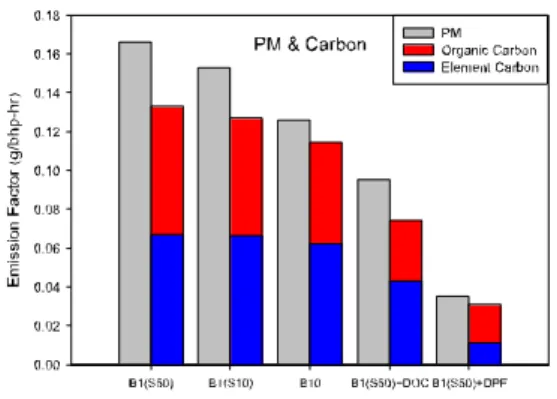2011 International Conference on Aerosol Science and Technology and 2011 Symposium of PM2.5 Regulated Standard and Control Strategy Oral B2-3
47
Emission Characteristics of Carbonaceous Particulate Matter from A Heavy-Duty Diesel Engine under Transient and Steady Cycles
Man-Ting Cheng1*, Hsun-Jung Chen1, Li-Hao Young2, Hsi-Hsien Yang3, Ying I. Tsai4, Lin-Chi Wang5, Jau-Huai Lu6, Chung-Bang Cheng7
1Department of Environmental Engineering, National Chung Hsing University, Taichung, Taiwan 2Department of Occupational Safety and Health, China Medical University, Taichung, Taiwan
3Department of Environmental Engineering and Management, Chaoyang University of Technology, Taichung, Taiwan 4Department of Environmental Engineering and Science, Chia Nan University of Pharmacy and Science, Tainan,
Taiwan
5Department of Chemical and Materials Engineering, Cheng Shiu University, Kaohsiung, Taiwan 6Department of Mechanical Engineering, National Chung Hsing University, Taichung, Taiwan
7Fuel Quality and Engine Performance Research, Refining and Manufacturing Research Institute, Chinese Petroleum Corporation, 217, Chiayi City, Taiwan
*Corresponding Author, Tel: +886 4-2285-1984, E-mail: mtcheng@dragon.nchu.edu.tw
ABSTRACT
This study presents the emission characteristics of organic and elemental carbon (OC and EC) in the total and fine particulate matter (TPM and PM2.5) from a heavy-duty diesel engine under the FTP transient cycle and four steady cycles of varying engine load. Three test fuels and two aftertreatments include low-sulfur diesel (LSD), ultralow-sulfur diesel (ULSD), 10% waste cooking oil biodiesel (B10), diesel oxidation catalyst (DOC), and DOC plus diesel particulate filter (DOC+DPF) were tested on the engine to examine their impact on the particulate OC and EC. The results show that the particulate total carbon (TC) correlates well with the TPM and PM2.5, based on all the emission tests. However, the OC/EC ratios could change drastically with different fuels, aftertreatments and engine load. In reference to the LSD and with no aftertreatment, the DOC+DPF shows the highest TPM and TC reductions, followed by the DOC and then the B10; minor differences (<10%) were observed between the LSD and ULSD. The OC/EC ratio of 0.99 for the reference case decreased to a minimum of 0.72 for the DOC, suggesting the DOC removes the semivolatile OC more effectively than the nonvolatile EC. In the contrary, the DOC+DPF resulted in a maximum OC/EC ratio of 1.73, verifying its relative high reduction efficiencies for nonvolatile EC,
and hence the OC absorbed on the EC. Substantially higher OC/EC ratios (> 3) were observed at idle and low load, compared to that of < 1 at medium and high load. The relatively higher OC emissions are likely due to the less complete combustion and hence lower combustion temperature at idle and low load. In addition, the OC emissions decreased significantly from low to medium load and then remained relatively unchanged from medium to high load. Unlike OC, the EC emissions increased with increasing load. Overall, the present study shows that fuels, aftertreatments and engine load can lead to compositional changes in the carbonaceous PM, of which need to be taken into account for assessing their impact on atmospheric chemistry and human health.
Keywords: Heavy-duty diesel engine, Diesel engine particles, Organic carbon, Elemental carbon, Control technology
INTRODUCTION
Diesel engines are widely used as a source of power in the transportation and industrial sectors, such as on-road vehicles and non-road equipment, due to their durability, high power output and fuel economy. Diesel exhaust (DE) is a complex mixture that contains gaseous pollutants and particulate matter (PM) with diameters primarily less than 2.5 m (PM2.5).
2011 International Conference on Aerosol Science and Technology and 2011 Symposium of PM2.5 Regulated Standard and Control Strategy Oral B2-3
48 The PM components are composed predominantly of carbonaceous material in the form of elemental carbon (EC) and organic carbon (OC).1 Collectively, the DE contributes to adverse human health effects, restricted visibility, acid rain, and global climate change.2,3
The EC in diesel PM is formed by the pyrolysis of the unburned fuels at temperatures above 1300 K, while the OC is produced as a result of incomplete combustion of fuel and lubricant oil. The highest EC contribution to PM2.5 was typically observed for heavy-duty diesel engine (HDDE), followed by light-duty diesel engine, and then gasoline engines; on average, the EC contributed to 75% of the diesel PM and ~ 25% of gasoline PM.2
HDDE buses and trucks are of special interest as they contributed to ~56% of the total PM2.5 from mobile sources, despite constituting only < 0.2% of the total fleet in Taiwan.4 In addition, diesel engine typically has a life expectancy of 20-30 years. With that in mind, this paper examines the emission characteristics and reduction efficiencies of the total PM (TPM), PM2.5, and particulate OC and EC in HDDE exhaust equipped with a prototype DOC+DPF and selected alternative fuels. FIGURES AND TABLES
Figure 1. The TPM and PM2.5 emission factors with
various loads under steady cycle.
Figure 2. The OC and EC emission factors in TPM for each test under transient cycle.
Acknowledgments
The authors wish to thank the financial and administrative support from the National Science Council and the Environmental Protection Administration, Taiwan, Republic of China under the contract numbers NSC-98-EPA-M003-002 and NSC-99-EPA-M-002-002.
REFERENCES
1. Kleeman, M.J.; Robert, M.A.; Riddle, S.G.;Jakober, C.A.;Hannigan, M. Coordinating Research Council, Inc., Georgia, 2007; CRC Report No. E-55-59 1.5a.
2. US EPA, National Center for Environmental Assessment, Office of Transportation and Air Quality, 2002; EPA/600/8-90/057F.
3. Eldering A.; Cass, G.R. J. Geophy. Res. 1996, 101,19343-19369.
4.Taiwan Emission Data System (TEDS), http://ivy2.epa.gov.tw/air-ei/new_main2-0-1.htm, (accessed May 2011).
